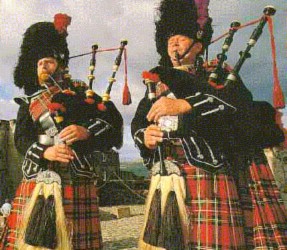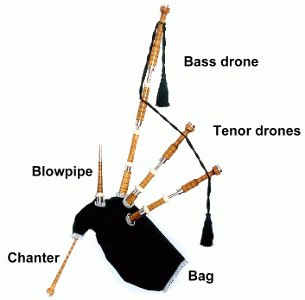   When people think of bagpipes, they usually associate them with Scotland. However, the bagpipes are an ancient instrument found in many cultures all over the world. The first form of this instrument can apparently be traced back to the Middle East, centuries before Christ.
When people think of bagpipes, they usually associate them with Scotland. However, the bagpipes are an ancient instrument found in many cultures all over the world. The first form of this instrument can apparently be traced back to the Middle East, centuries before Christ. The pipes were later popular in all of Europe during the Medieval and Renaissance periods. Early pipes were made from animal skin, with hollow leg bones of small animals attached; holes drilled into the bones allowed musicians to produce various pitches and tones. The bagpipes were introduced to Scotland from Ireland. The Scots added a third drone (see below) and applied their own tartans to the bags. Village musicians may have first used the bagpipes and drums to entertain. The pipes were also played at funerals. Bagpipes were used by the Scots in battle against the English probably because the English found them to be disturbing and unsettling. (Eventually the English banned the instrument, along with other traditions that they felt were threatening). On this page we'll look at Scotland's Great Highland Bagpipes.  Traditionally, the bag was made of sheep leather, made airtight by treating it with honey or molasses. Today pipe bags are made from Gore-Tex, and treated with sealant.
Traditionally, the bag was made of sheep leather, made airtight by treating it with honey or molasses. Today pipe bags are made from Gore-Tex, and treated with sealant.The pipes were originally made of a hardwood, such as ebony, and decorated with ivory or silver. Today's pipes are usually made of less expensive wood, or plastic resins. The piper breathes air into the blowpipe to keep the bag full. The blowpipe has a one-way valve so air can't get back out that way. The bag is then squeezed under the arm to force air out of the other four pipes. Three of the pipes are called drones - two tenor and one bass. These lay across the piper's shoulder and produce the constant humming sound. The last pipe is the chanter; held in the hands, its holes allow a melody to be played with the fingers.  Bagpipes play only nine notes. They are not set in the
usual Western major or minor scales; instead they use a somewhat different scale of half tones. Bagpipes have no volume control; they were designed as an outdoor instrument. Bagpipes play only nine notes. They are not set in the
usual Western major or minor scales; instead they use a somewhat different scale of half tones. Bagpipes have no volume control; they were designed as an outdoor instrument.The chanter and drones contain vibrating reeds like other wind instruments; the chanter reed is double-bladed, so it's the loudest. The chanter has eight holes which are covered by the player's fingers. It works just like a flute; if some holes are uncovered; the length of the vibrating air column inside is shortened, raising the pitch. The chanter has a bell-shaped flare at the bottom like a trumpet, which also helps produce a louder sound. The drones - the long pipes that rest on the shoulders - each have only one hole at the end, so each plays just one note. The bass drone is one octave below the tenor drones, which are in turn one octave below the chanter. The upper sections of the drones are built so that they can slide in and out; by altering their length they can be tuned. By lifting one of the fingers on the chanter very quickly, a small 'blip' of sound at a higher pitch is created; this is used to separate notes, so that the rhythm of the melody can be heard. This and other techniques make the bagpipes difficult to play well, but give the music its distinctive sound. Scotland the Brave | Amazing Grace | Tura Lura |